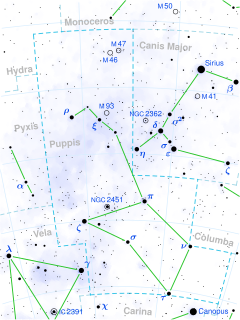k Puppis
| Observation data Epoch J2000.0 Equinox J2000.0 | |
|---|---|
| Constellation | Puppis |
| k1 Pup | |
| Right ascension | 07h 38m 49.380s[1] |
| Declination | −26° 48′ 06.49″[1] |
| Apparent magnitude (V) | +4.50[2] |
| k2 Pup | |
| Right ascension | 07h 38m 49.869s[1] |
| Declination | −26° 48′ 13.80″[1] |
| Apparent magnitude (V) | +4.429[1] |
| Characteristics | |
| k1 | |
| Spectral type | B6 V[3] |
| k2 | |
| Spectral type | B5 IV[3] |
| Variable type | SX Ari[4] |
| Astrometry | |
| Parallax (π) | 9.41 ± 0.80 mas[5] |
| Distance | 350 ± 30 ly (106 ± 9 pc) |
| k1 | |
| Absolute magnitude (MV) | −1.19[6] |
| k2 | |
| Absolute magnitude (MV) | −0.94[6] |
| Details[6] | |
| k1 | |
| Mass | 4.3±0.3 M☉ |
| Radius | 3.7+1.2 −0.6 R☉ |
| Luminosity | 490 L☉ |
| Surface gravity (log g) | 4.24±0.15 cgs |
| Temperature | 13,600±1,200 K |
| Rotational velocity (v sin i) | 114±5 km/s |
| k2 | |
| Mass | 6.0±0.3 M☉ |
| Radius | 3.0+0.7 −0.3 R☉ |
| Luminosity | 1,202 L☉ |
| Surface gravity (log g) | 4.10±0.15 cgs |
| Temperature | 18,500±500 K |
| Rotational velocity (v sin i) | 61±5 km/s |
| Other designations | |
| k1: HR 2948, HD 61555, SAO 174198 | |
| k2: HR 2949, HD 61556, SAO 174199 | |
| Database references | |
| SIMBAD | k Puppis |
| k1 | |
| k2 | |
k Puppis (k Pup, k Puppis) is a Bayer designation given to an optical double star in the constellation Puppis, the two components being k1 Puppis and k2 Puppis.
Bayer designation
[edit]Note that the Bayer designation for this star is "k" not "kappa" (κ). In Bayer's original Uranometria, k Puppis was listed as ρ (rho) Navis.[7] When Lacaille broke apart the large constellation Argo Navis into Carina, Puppis, and Vela, he re-designated the stars with Greek letters in a single sequence across all three constellations. Additionally, Lacaille used Latin letters for many additional stars. κ (kappa) is in the constellation of Vela and so there is no kappa in Puppis.[8] The confusion also extends to the proper name Markab which properly applies to κ Velorum (and other stars) but which has also been used for k Puppis when it is called κ Puppis.[9]
Description
[edit]
Both k1 Puppis and k2 Puppis are bright blue B-type stars of nearly equal brightness, +4.50 and +4.62, respectively. To the naked eye, the pair has a combined magnitude of +3.80. On the sky, the two stars are separated by approximately 9.9 seconds of arc along PA 318°. The optical pair can be distinguished easily with a small telescope. The component k1 Puppis is a binary star system in its own right, while k2 Puppis is a variable star. Each star within the k Puppis optical pair is between 450 and 470 light years from Earth.
k Puppis is listed in the General Catalogue of Variable Stars as a suspected variable star, but the range and type are not stated. The International Bulletin of Variable Stars has since published research showing that k2 Puppis is the variable component. It is an SX Arietis variable with a period of 1.9093 days which is also the rotational period of the star. The total amplitude is 0.015 apparent magnitude.[4]
k2 Puppis is a chemically peculiar star with a strong magnetic field. It is classified as a He-weak star and in addition to a deficit of helium in its spectrum, it shows an overabundance of many iron peak and rare earth elements. All of its spectral lines show variability, probably due to variations in the chemical makeup of its atmosphere as it rotates.[6]
References
[edit]- ^ a b c d e Høg, E.; et al. (2000). "The Tycho-2 catalogue of the 2.5 million brightest stars". Astronomy and Astrophysics. 355: L27–L30. Bibcode:2000A&A...355L..27H.
- ^ Ducati, J. R. (2002). "VizieR Online Data Catalog: Catalogue of Stellar Photometry in Johnson's 11-color system". CDS/ADC Collection of Electronic Catalogues. 2237. Bibcode:2002yCat.2237....0D.
- ^ a b Houk, N (1982). "Michigan Catalogue of Two-dimensional Spectral Types for the HD stars. Volume_3. Declinations -40_ƒ0 to -26_ƒ0". Michigan Catalogue of Two-dimensional Spectral Types for the HD stars. Volume_3. Declinations -40_ƒ0 to -26_ƒ0. Bibcode:1982mcts.book.....H.
- ^ a b Rivinius, Th; Stahl, O; Baade, D; Kaufer, A (2003). "A New Bright Helium Variable B Star: HR 2949". Information Bulletin on Variable Stars. 5397: 1. Bibcode:2003IBVS.5397....1R.
- ^ Van Leeuwen, F (2007). "Validation of the new Hipparcos reduction". Astronomy and Astrophysics. 474 (2): 653–664. arXiv:0708.1752. Bibcode:2007A&A...474..653V. doi:10.1051/0004-6361:20078357. S2CID 18759600.
- ^ a b c d Shultz, M; Rivinius, Th; Folsom, C. P; Wade, G. A; Townsend, R. H. D; Sikora, J; Grunhut, J; Stahl, O; MiMeS Collaboration (2015). "The magnetic field and spectral variability of the He-weak star HR 2949". Monthly Notices of the Royal Astronomical Society. 449 (4): 3945. arXiv:1504.03289. Bibcode:2015MNRAS.449.3945S. doi:10.1093/mnras/stv564.
- ^ "Linda Hall Library Bayer, Johann, Explicatio...Uranometrias". Retrieved 2016-10-14.
- ^ Ian Ridpath. "Argo Navis". Star Tales. Retrieved 27 Jan 2015.
- ^ Kostjuk, N. D. (2004). "VizieR Online Data Catalog: HD-DM-GC-HR-HIP-Bayer-Flamsteed Cross Index (Kostjuk, 2002)". VizieR On-line Data Catalog: IV/27A. Originally Published in: Institute of Astronomy of Russian Academy of Sciences (2002). 4027. Bibcode:2004yCat.4027....0K.
- ^ "MAST: Barbara A. Mikulski Archive for Space Telescopes". Space Telescope Science Institute. Retrieved 26 September 2022.

